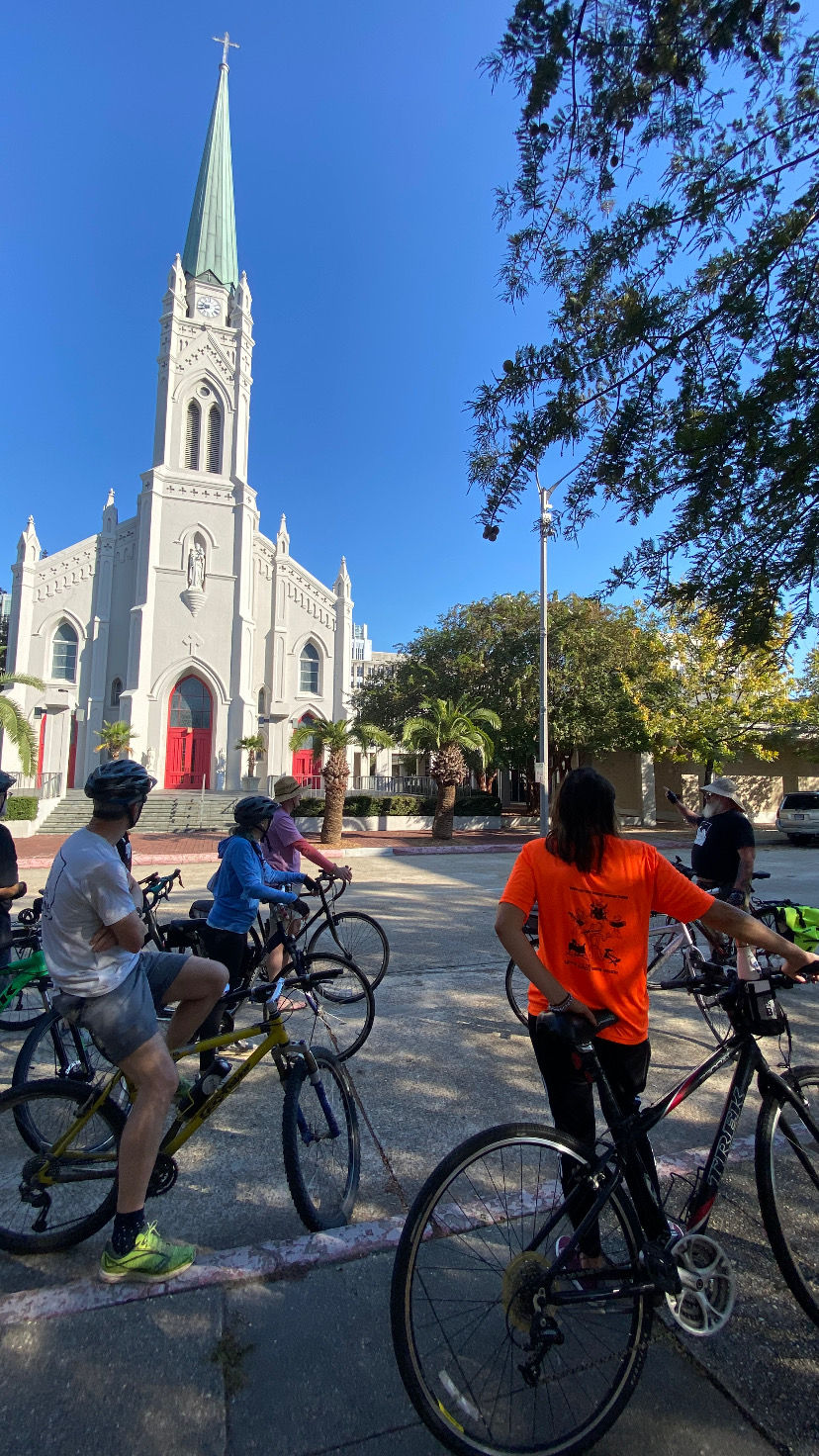Velo Muertos 2024
- Samantha Morgan

- Nov 3, 2024
- 4 min read
Led by guide Mark Martin, the 2024 Velo Muertos bike tour explored the historic cemeteries and burial grounds of Baton Rouge, weaving tales of notable figures, cultural traditions, and fascinating lore surrounding these resting places.
Mark started leading this tour of the cemeteries in 2009 as an effort to encourage people to ride bicycles in town. At the time, Bike Baton Rouge offered guided, themed rides, so this ride became one of those events.
Here’s a summary of each stop on the 2024 tour:

Stop 1: The Indian Mound at the State Capitol
The first stop was an Indian mound near the State Capitol, which, despite common belief, is not a burial ground. The flat-topped shape suggests it once held a wooden structure, possibly for a tribal chief. However, the arrival of European settlers led to the mound’s gradual repurposing. The U.S. Army, stationed nearby, used its top to bury officers, who were later moved, fitting the Halloween “walking dead” theme for the day. The mound’s distinctive shape, weathered but mostly original, mirrors the stair-like architectural forms nearby and aligns directly with the Capitol’s central axis. A lesser-known water fountain featuring a Native American figure stands nearby, suggesting a link to the site’s historical foundation. The fountain is inactive and little is known about its origins or intended meaning.
Stop 2: St. Joseph Cathedral and Cemetery
Next, the tour stopped at St. Joseph Cathedral. Originally a Catholic church and later designated as a cathedral, St. Joseph’s early cemetery was moved in part during city expansions. Baton Rouge’s violent Civil War history left its mark here when, in 1863, a Union cannonball shot through the church and above the altar. The priest petitioned the federal troops for reparations, a request that was eventually rebuffed, even resulting in his brief imprisonment. St. Joseph’s history of resilience reflects the long-lasting impacts of war, with a reminder from Martin that calls for civil conflict today overlook the devastating toll on communities.

Stop 3: St. Joseph Catholic Cemetery
St. Joseph Cemetery, one of Baton Rouge’s oldest Catholic cemeteries, holds an array of historic graves. Segregated by religion, St. Joseph was Catholic, while Protestant and Jewish cemeteries were designated elsewhere. Some notable symbols found here, such as tree trunks with limbs and tops cut short, represent lives taken too early. Unique to Baton Rouge’s lower water table, most graves are in-ground rather than above ground, unlike cemeteries in New Orleans. Interestingly, evergreens line many graves as symbols of eternal life, creating a serene, timeless atmosphere.

Stop 4: Baton Rouge Jewish Cemetery
The Jewish Cemetery, dating back to the 1840s, represents Baton Rouge’s long-standing Jewish community, which was integral to the city’s early days. During the 1800s, St. Francisville was known as “New Jerusalem” because of its flourishing Jewish population. The tour noted distinct Jewish traditions, including the custom of placing stones rather than flowers on headstones as a mark of remembrance. Stones symbolize the permanence of memory over the fleeting nature of flowers, with each stone left as a prayer to bind the soul with eternal life.

Stop 5: Magnolia Cemetery
Magnolia Cemetery once lay on the outskirts of Baton Rouge, with Laurel Street providing a tree-lined walkway to this communal resting place. Established without specific religious affiliation, Magnolia was one of the few cemeteries open to all, hosting both the elite and the impoverished. Once a spot for family outings, picnics, and public events, the cemetery grounds were landscaped with evergreens to symbolize eternal life. Magnolia’s significance extends beyond graves, with plots for the wealthy as well as a “paupers’ field” for those without means. During this stop, there was discussion about the recently discovered occupant, Alex Gilbert.

Stop 6: Baton Rouge National Cemetery
The National Cemetery, established in 1864 and formalized as a national site in 1867, is laid out with military precision, marking the resting places of soldiers from the Civil War and beyond. Unlike the local cemeteries, the headstones here are uniform, creating an orderly arrangement. Notably, the cemetery was among the first integrated burial grounds, with United States Colored Troops—many of whom fought courageously at the long siege of Port Hudson—buried along its eastern edge. Mark Martin pointed out that the cemetery’s design emphasizes the unity and equality of service, regardless of race or background.

Stop 7: Sweet Olive Cemetery
The last stop, Sweet Olive Cemetery, highlighted some of Baton Rouge’s complex history around race and burial practices. Although ownership records are incomplete, Sweet Olive is known as an African American cemetery. Graves here are packed tightly together, and unlike other cemeteries, many crypts lack individual markings, underscoring the disparities in how communities are remembered. This site is often neglected, with crypts sometimes left open and subject to subsidence from the area’s low elevation. Efforts are underway to establish regular maintenance, though the cemetery’s current condition is a powerful reminder of the importance of preserving burial sites.

From hidden histories to cultural traditions and shifting burial practices, the Velo Muertos tour through Baton Rouge’s cemeteries offered a unique glimpse into the city’s heritage, drawing together stories of the living and the dead in a shared journey through history.
You can purchase the Velo Muertos shirt from the store and be ready to ride next year!












Comments